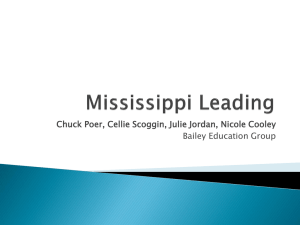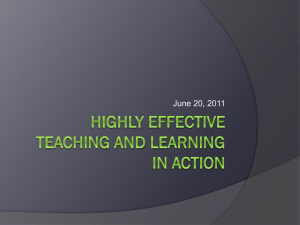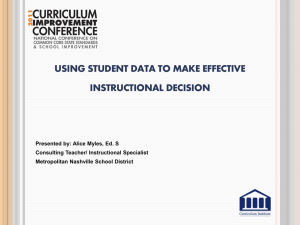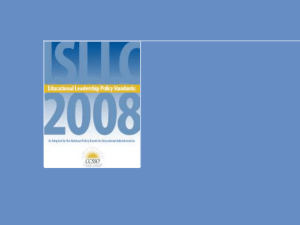students - International Center for Leadership in Education
advertisement
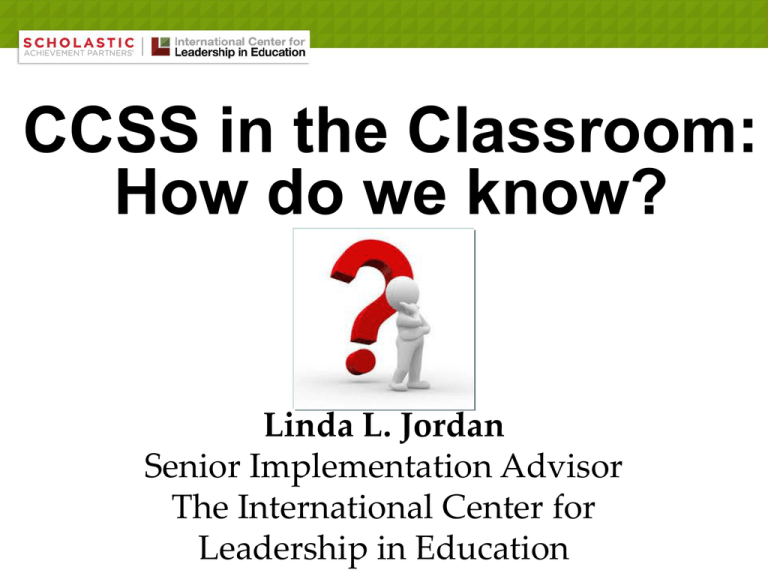
CCSS in the Classroom: How do we know? Linda L. Jordan Senior Implementation Advisor The International Center for Leadership in Education Agenda Welcome Elements of Effective Instruction Closing Collaborative Instructional Review Process Relationship Building How would you describe the relationships in your building between the following groups? Staff to Staff Staff to Student Staff to Administration Staff to Parent Staff to Community Staff to Student Learning Outcomes • Define a common voice and expectations for rigorous, relevant, and engaging instruction. • Provide standards-aligned, rigorous, and relevant instructional support to instructional leaders. • Engage in a collaborative process with staff to align lesson planning and delivery to higher standards. . OUR FOCUS Having ONE Voice - Sharing the message/the focus It’s about Instruction – Using Common Vocabulary – Talking about Student Learning & Instruction – Being Collaborative, Not Evaluative Elements of an Effective Lesson Elements 1. 2. 3. 4. Define Plan and Prepare Teach Reflect Define • Lesson Title: • Subject: • Grade Level: • Lesson Description: • Lesson Duration: • Outcomes: (enduring understandings, essential questions, or guiding themes) Lesson Delivery 1. Introduction – Do Now and Opening 2. Lesson Flow – Quad D, Gradual Release, Problem Solving, Close Reading 3. Closing – Reflection and Next Steps Teach 1. Lesson Introduction 2. Flow(Teach) Quad D Format • Multiple short segments of instruction: • Quad D Model: • Investigate• Justify• Real World Application• Checks for Understanding/Feedback: • Differentiation: • Application: 3. Lesson Closure • Assessment: • Homework/Extension/Home Connection: Two Key Areas to Focus On Introduction Closing Introduction • How will you engage students? • Which instructional strategies will you use? • What is the vocabulary that will be needed? • What are your goals? Closing • How will you end the lesson? • Last 5 minutes of the lesson • Reflection/processing to raise rigor and relevance • Align to standards • Assessment Lesson Flow Many models for lesson design/delivery 4 Examples Gradual Release I do We do You do Close Reading FIRST READING Read for general understanding. SECOND READING Dig deeper into language and ideas. THIRD READING Synthesize information and cite evidence. Close Reading Teach Academic Vocabulary Multiple Reading Text-Based Question/Academic . Discussion Problem Solving INTRODUCTION Establish a purpose. EXPLORATION Engage in the problem. SUMMARIZATION Connect new thinking. Quadrant D Investigate Justify Real World Application Collaborative Instructional Review Process The Conversation is the Relationship A Formative Process • Focuses on students • Helps guide the thinking and the work of instructional planning • Uses the data to inform and guide professional dialogue • Helps professionals make decisions about increasing rigor, relevance, and student engagement in lessons • Collaborative, Not Evaluative What do you remember about the Rigor/Relevance Framework? Rigor/Relevance Framework TM 6 5 4 3 2 1 1 2 3 4 5 Rigor/Relevance Framework Evaluation TM 6 “Judge the Outcome” Adaptation Knowledge Taxonomy Assimilation Synthesis 5 “Putting Together” Analysis Students have the competence, that when confronted with perplexing unknowns they are able to use their extensive knowledge base and skills to create unique solutions and take action that further develops their skills and knowledge. Student Thinks Student Thinks and Works (Relationships Important) (Relationships Important) 4 “Taking Apart” Application Students extend and refine their knowledge so they can use it automatically and routinely to analyze and solve problems and create solutions 3 “Making use of Knowledge” Comprehension 2 “Confirming” Knowledge Acquisition 1 “Information Gathering” Relevance Makes Rigor Happen! Application Students gather and store bits of knowledge and information and are expected to remember or understand this acquired knowledge. Teacher Works Students use acquired knowledge to solve problems, design solutions, and complete work. The highest level of application is to apply appropriate knowledge to new and unpredictable situations. Student Works (Relationship of little Importance) (Relationships Important) 1 2 3 4 5 Knowledge in ???? Discipline Apply Knowledge in ???? Discipline Apply Knowledge Across Disciplines Apply Knowledge to Real World Predictable Situations Apply Knowledge to Real World Unpredictable Situations Application Model CONSIDER…. Who is doing the work? Who is doing the thinking? Student Roles Collaborating to Increase Instructional Effectiveness 80/20 Rule 80% observing/listening to what the students are doing and saying 20% observing/listening to the instructional design Rubric Overview Share out big ideas/questions/observations RIGOR Evidence of Rigor Build effective instruction based on rigorous and relevant expectations (DSEI Teaching Element #1) Plan and provide learning experiences using effective research-based strategies that are embedded with best practices, including the use of technology (DSEI Teaching Element #4) Thoughtful Work Lesson intentionally prepares students to complete a range of high-quality learning tasks. Student Learning Instructional 1 - Beginning Students demonstrate their learning by completing tasks that require critical thinking skills such as knowledge/awareness and comprehension. Most tasks focus on responding to textbooks or content through answering recall-type questions. Learning task results in one standard type of work product to 2 - Developing Students demonstrate their learning by completing tasks that require application and analysis. There are opportunities for students to demonstrate mastery through learning tasks that require them to apply knowledge and analyze content. Learning task includes a one or more work products 3 - Meeting Students regularly complete learning tasks that demonstrate their ability to analyze, synthesize, and/or evaluate new instructional content. Tasks include the opportunity for students to respond to content using creativity, originality, and/or adaptation. Learning task provides students with options for self- Build effective instruction based on rigorous and relevant expectations (DSEI Teaching Element #1) Plan and provide learning experiences using effective research-based strategies that are embedded with best practices, including the use of technology (DSEI Teaching Element #4) High-Level Questioning Lesson provides opportunities for students to respond to a range of questions that increase in rigor and levels of thinking. 1 - Beginning Student Learning Instructional Design 2 - Developing 3 - Meeting Students respond to questions that mainly focus on critical thinking skills such as basic recall, retell, and/or comprehension. Few students ask questions, and most questions asked focus on basic knowledge or comprehension of content. Students respond to questions that demonstrate a range of levels of thinking, including questions that require application and analysis of information. Students have opportunities to ask questions during the lesson and most questions are relational or application-based, focusing on why and cause and effect. Students fully explain and justify their thinking when responding to questions that demonstrate a range of levels of thinking, including questions that require synthesis and evaluation of information. During the lesson, students generate questions about content that demonstrate rigorous independent thinking. Lesson mainly includes questions at the comprehension level, and/or not all students are required to respond to each question. Lesson includes questions at a range of levels, but not all students are required to respond to each question. Lesson is designed to carefully support students in moving to higher levels of thinking (such as justifying responses with evidence), ensuring that all students have an opportunity to respond. Evidence of Rigor Build effective instruction based on rigorous and relevant expectations (DSEI Teaching Element #1) Plan and provide learning experiences using effective research-based strategies that are embedded with best practices, including the use of technology (DSEI Teaching Element #4) Academic Discussion Lesson includes opportunities for students to engage in vocabulary-rich academic conversation with peers. 1 - Beginning 2 - Developing 3 - Meeting Student Learning Instructional Design Student conversation mainly remains at the retell level, mostly using everyday language, with little to no evidence of academic or domainspecific vocabulary. Student conversation focuses on a variety of topics, with each student offering his/her own thinking, without building on thoughts offered by peers. Student conversation includes a combination of retelling, analysis, and/or stating a claim and defending it with evidence. Students provide explanations or evidence of their thinking and respond to their peers’ discussions. Lesson mostly structures discussion as teacher-led, with the majority of conversations as Lesson structures discussion as a mix of teacher-led and peerto-peer with the teacher facilitating the Students engage with peers in daily academic conversations focused on analysis, synthesis, and evaluation of content-driven topic, using academic language to express their thinking. Students support their ideas with concrete explanations and evidence, paraphrasing as appropriate, and build on or challenge the ideas of others. Lesson mostly structures discussion as independent peerto-peer. The teacher facilitates and redirects Relevance Evidence of Relevance Build effective instruction based on rigorous and relevant expectations. (DSEI Element #1) Possess and continue to develop content area knowledge to make it relevant to the learner (DSEI Element #3) Plan and provide learning experiences using effective research-based strategies that are embedded with best practices. (DSEI Element #4) Meaningful Work Lesson requires students to complete relevant, real-world tasks that connect to tasks typically completed in related careers. 1 - Beginning 2 - Developing 3 - Meeting Student work is Students think critically Students think critically procedural and about content and about content and structured, reflecting a apply information apply information basic understanding of learned to address a learned to address a information learned specific task. Student range of crossduring the lesson/unit. work demonstrates disciplinary tasks. Student work focuses originality. Student work on class-specific Student work requires demonstrates Student Learning content with an application of creativity and emphasis on building knowledge learned originality. skills, developing during the lesson/unit. Student work requires comprehension, or real-world predictable other foundational skills. and/or unpredictable application that has a direct connection to a career in the related field of study. Lesson provides Lesson provides Lesson provides students an opportunity students an students an to demonstrate opportunity to opportunity to select Instructional Design foundational complete a specific from a range of real- Evidence of Relevance Build effective instruction based on rigorous and relevant expectations. (DSEI Element #1) Possess and continue to develop content area knowledge to make it relevant to the learner (DSEI Element #3) Plan and provide learning experiences using effective research-based strategies that are embedded with best practices. (DSEI Element #4) Authentic Resources Lesson includes a range of sources of information and requires students to use information from sources with relevant, real-world tasks. 1 - Beginning 2 - Developing 3 - Meeting Student Learning Instructional Design Students mainly engage with the textbook as the source of information for the lesson and/or unit. Students mainly use the textbook to complete classroom tasks focused on knowledge in one discipline. Students engage with the textbook as a primary source of information for the lesson and/or unit, using supplementary resources to support textbook information. Students use the textbook and supplementary resources to complete some relevant, realworld tasks. Lesson is structured around an essential understanding/ question and includes opportunities for Lesson relies on the textbook as the main source of information. The unit/lesson is organized around the Students engage with multiple sources of information during a lesson/unit, including primary sources, secondary sources, textbooks, and media resources. Students use multiple sources of information to conduct comparisons, analysis, argument, research, and other relevant, real-world tasks. Lesson is structured around an essential understanding/ question and relies on multiple authentic texts Evidence of Relevance Build effective instruction based on rigorous and relevant expectations. (DSEI Element #1) Possess and continue to develop content area knowledge to make it relevant to the learner (DSEI Element #3) Plan and provide learning experiences using effective research-based strategies that are embedded with best practices. (DSEI Element #4) Learning Connections Lesson includes a variety of opportunities for students to make connections between what they are learning and real-world applications. 1 - Beginning 2 - Developing 3 - Meeting Student Learning Instructional Design Students seldom have the opportunity to engage in content that has explicit connection to real-world application. Some students may attempt to make connections between content learned and real-world application, but these connections are volunteered rather than included as part of the lesson. Lesson provides appropriate content but does not make explicit connections to realworld application. Students occasionally engage in content that has explicit connection to real-world application. Some students begin to articulate the connections between content learned and real-world application. Students consistently engage in content that has explicit connection to real-world application. Students clearly articulate the connections between content learned and real-world application. Lesson provides some opportunities to connect content learned to real-world application. Lesson provides multiple explicit opportunities for students to connect content learned to realworld applications. Learner Engagement Evidence of Learner Engagement Create and implement an effective learner environment that is engaging and aligned to learner needs. (DSEI Element #2) Use assessment data to guide and differentiate instruction. (DSEI Element #5) Active Participation Lesson is designed to maximize engagement of all students throughout the duration of the lesson. 1 - Beginning 2 - Developing 3 - Meeting Most student Students remain focused Students remain on-task and engagement is and on-task during the engaged throughout the lesson. All through handlesson. Students answer students are actively involved in raising. Some questions when asked, routine as designed. students are off-task but not all students have Students lead their own progress or have disengaged the opportunity to through learning new content, from the lesson and respond verbally. working productively and Student are not redirected. Led by the teacher, collaboratively. Learning Led by the teacher, students progress students progress through learning new through learning new content productively. content with some challenges with productivity. Instructional Design Lesson relies mainly on direct instruction with few opportunities for student engagement through application. Lesson relies on one or two strategies designed to engage students, with the lesson focused more on direct instruction than on student engagement through application. Lesson provides multiple strategies designed to maximize student engagement, achieving a strong balance of direct instruction and student engagement through application. Evidence of Learner Engagement Create and implement an effective learner environment that is engaging and aligned to learner needs. (DSEI Element #2) Use assessment data to guide and differentiate instruction. (DSEI Element #5) Learning Environment Classroom environment is centered around a culture of respect and commitment to learning. Student Learning Instructional Design 1 - Beginning Students rely on peers or teacher for answers to questions. There is a lack of evidence of students being required to persevere in responding to rigorous tasks or questions. Students demonstrate a lack of respect for peers, teacher, and/or learning environment. 2 - Developing Some evidence that students are beginning to take risks and persevere in learning rigorous content. Students demonstrate respect for the learning environment, but challenges exist in demonstrating respect for peers. 3 - Meeting Students are encouraged to take risks and persevere through productive struggle. Students are praised for demonstrating commitment to learning. Students consistently demonstrate respect for peers, teacher, and the learning environment. Classroom procedures and routines are visible, but are not consistently implemented. Clear classroom procedures and routines are visible and are consistently implemented. Classroom procedures and routines are inconsistently communicated and/or implemented. Evidence of Learner Engagement Create and implement an effective learner environment that is engaging and aligned to learner needs. (DSEI Element #2) Use assessment data to guide and differentiate instruction. (DSEI Element #5) Formative Processes and Tools Lesson is tailored to meet the needs of all students, including using results from formative tools and processes to plan for differentiated instruction. 1 - Beginning 2 - Developing 3 - Meeting Students demonstrate Students demonstrate Students demonstrate mastery of mastery of content by mastery of content by content by completing a variety of completing infrequent regularly engaging in formative assessments that allow formative assessments. formative assessments for reciprocal feedback. Assessment results that allow for Assessment results indicate that indicate that student reciprocal feedback. students are achieving expected growth is minimal. Assessment results outcomes and are able to self Students are partnered indicate that student reflect and share responsibility for Student or grouped, but all growth is progressing. their learning. Learning students receive the Students are partnered Students are regularly and same lesson content, or grouped and strategically partnered or grouped process, and product. receive some based on data, and lesson content, opportunities for process, and/or product is differentiated learning differentiated to support varying based on adjusting student needs. content, process, and/or product. Instructional Design Results from formative processes and tools are used to monitor progress. Results from formative processes and tools are used to plan differentiated instruction and monitor Results from formative processes and tools are used to immediately adjust instructional pacing, plan differentiated instruction, and monitor progress. Previewing the Rubrics Rigor What did we notice? What questions do we have? Relevance Engagement 4 Phase Process Phase 1: Pre-Visit Phase I: The Pre-Visit Meeting • Discuss focus of the lesson • Discuss teacher’s vision • Reflect on the Rigor, Relevance and Engagement rubrics • Reflect on the meeting itself Pre-Visit Questions Pre-Visit Lesson Reflection Form Directions: Teachers: complete this form and share with the Instructional Leader/Reviewer during the Pre-Visit Meeting. Name: Date of Observation: Lesson Title: 1. Why is your lesson plan is the right one for today? 2. What are you doing to help students accomplish the goals of the lesson? 3. What do you hope to see students do and/or hear students say? 4. How will the students capture their thinking and work? 5. Are the goals of the lesson aligned to the rubrics? (Check off all ENGAGEMENT that apply.) RIGOR RELEVANCE □ Thoughtful Work □ Meaningful Work □ Active Participation □ High-Level Questioning □ Authentic Resources □ Learning Environment □ Academic Discussion □ Learning Connections □ Formative Processes and Tools Phase I: The Pre-Visit Meeting • Tell me why your plan is the right one for today. • What do you hope to see students do/hear students say? • What are you doing to help them get there? • How will the students capture their thinking and work? Phase II: The Visit 0 Visits 200+ Visits Phase III: The Debrief Phase III: The Debrief • Ask effective questions • Reflect on the rubric • Share notes • Give the final report to the teacher • Support teacher in action planning Phase IV: Applying the Action Plan Reflection Imagine you are introducing the four-step process to your teachers. Summarize the four phases of the process, including the benefits, to persuade them of its effectiveness. Modeling Using Evidence STEP 1 Watch the video and take copious notes. STEP 2 Use the Rigor Rubric to rate the student work. STEP 3 Use evidence from the video to support rating. Reflection on Rigor STEP 1 STEP 2 STEP 3 In Pairs: Share your thinking for Thoughtful Work, High-Level Questioning, and Academic Discussion. Come to Consensus: Discuss the evidence to support your rating. Share: At your table, share your rating and explanations. Collaborating for Relevance http://vimeo.com/74579104 Relevance is the purpose of learning. 5. REAL-WORLD UNPREDICTABLE 4. REAL-WORLD PREDICTABLE 3. APPLY ACROSS DISCIPLINES 2. APPLY KNOWLEDGE 1. AQUIRE KNOWLEDGE A Relevant Lesson Answers: • What am I learning? • Why am I learning it? • How will I use it? Meaningful Work • Clear that the teacher talk matches the student population • Clear that the teacher knows the students and uses examples that reflect the student population • Work is developmentally appropriate • Real-World • Connections to careers Authentic Resources • Multiple resources that reflect real world applications (careers) • Range of cross-disciplinary tasks • Tools include using digital, print, visual, auditory, video, text • Real manipulatives used when possible Learning Connections • Students connect the concepts and skills taught to examples from their lives • Students can articulate and discuss the concepts and skills • Students can explain how what they are learning is used in the real world. Relevance Reflection on Relevance STEP 1 STEP 2 STEP 3 In Pairs: Share your thinking on the relevance of the lesson. Come to Consensus: Discuss the evidence to support your rating. Calibration Discussion: How does your rating on each indicator compare? QuickWrite What feedback would you leave for this teacher before you leave the classroom? Collaborating for Engagement Engagement Engagement is the participation in learning. Active Participation • Students remain on-task and engaged throughout the lesson. All students are actively involved in routine as designed. • Students lead their own progress through learning new content, working productively and collaboratively. • Lesson provides multiple strategies designed to maximize student engagement, achieving a strong balance of direct instruction and student engagement through application. Learning Environment • Students are encouraged to take risks and persevere through productive struggle. Students are praised for demonstrating commitment to learning. • Students consistently demonstrate respect for peers, teacher, and the learning environment. • Clear classroom procedures and routines are visible and are consistently implemented. Formative Tools and Processes • Students demonstrate mastery of content by completing a variety of formative assessments that allow for reciprocal feedback. Assessment results indicate that students are achieving expected outcomes and are able to self-reflect and share responsibility for their learning. • Students are regularly and strategically partnered or grouped based on data, and lesson content, process, and/or product is differentiated to support varying student needs. • Results from formative processes and tools are used to immediately adjust instructional pacing, plan differentiated instruction, and monitor progress. Formative Assessment Strategies (Black, Wiliam,1998; Sadler, 1998; Stiggins, 2007;Heritage, 2007) • Pre-assessing students • Sharing Learning goals with students • Co-creating classroom discourse & questioning • Rich & challenging tasks elicit student response • Identifying gaps Formative Assessment Strategies (Black, Wiliam,1998; Sadler, 1998; Stiggins, 2007;Heritage, 2007) • Providing feedback/how to improve • Self-assessments • Peer- assessments • Opportunities to close the gap • Celebrations Feedback • Student Work Feedback Feedback • Student work • Student Proficient Celebrate Structured Routines • Choral Response • Pick and Point • Thumbs Up/Thumbs Down • Idea Wave What Else? • “Feedback has no effect in a vacuum; to be powerful in its effect, there must be a learning context to which feedback is addressed.” (2007 pg. 82) » Hattie, J. & Timperley, H. The power of feedback. Review of Educational Research Hattie & Timperley Formative assessment system: – Where am I going? (feed-up) – How am I doing? (feedback) – Where am I going next? (feedforward) Communicating Evidence-Based Feedback Effective Communication • Active listening • Verbal and Nonverbal Communication • Evidence-based • Starts with a positive • Direct and focused feedback • Actionable • Other? Verbal Formative Feedback INSTEAD OF… TRY… I liked your idea a lot! I liked the way you got students to think outside the box. Is it possible to make this even more rigorous by using different verbs? What does this mean? Can you explain this part to me in different words? Is there a way to word this to make it clearer to the student? I don’t think this will work. My students might have trouble with this unless I made sure to include _____ or say _____. Providing Effective Feedback Feedback on Rigor The questions you asked students were about basic recall of facts, a question to ask them is to compare and contrast the two characters in the text. Feedback on Relevance The textbook was the only resource I saw students using, you could also include a graphic or article from the web to provide more context. Feedback on Engagement The learning environment could use more structure when transitioning from one activity to the next, try assigning roles to students. Formative Feedback Ineffective You did a nice job on your analysis. The section on learning targets was strong. I like the topic for your activity. Students will really like this. Effective Learning Outcomes • Define a common voice and expectations for rigorous, relevant, and engaging instruction. • Provide standards-aligned, rigorous, and relevant instructional support to instructional leaders. • Engage in a collaborative process with staff to align lesson planning and delivery to higher standards. . Take-Aways About the Rubrics 1. Note two major take-aways. 2. Add one idea or suggestion. 3. Share! Two to Note, One We Wrote Takeaways about Using the Rubrics: 1. 2. One idea to add is… Linda L. Jordan ljordan@leadered.com 518-703-0114 ICLE 518-399-2776 www.leadered.com
